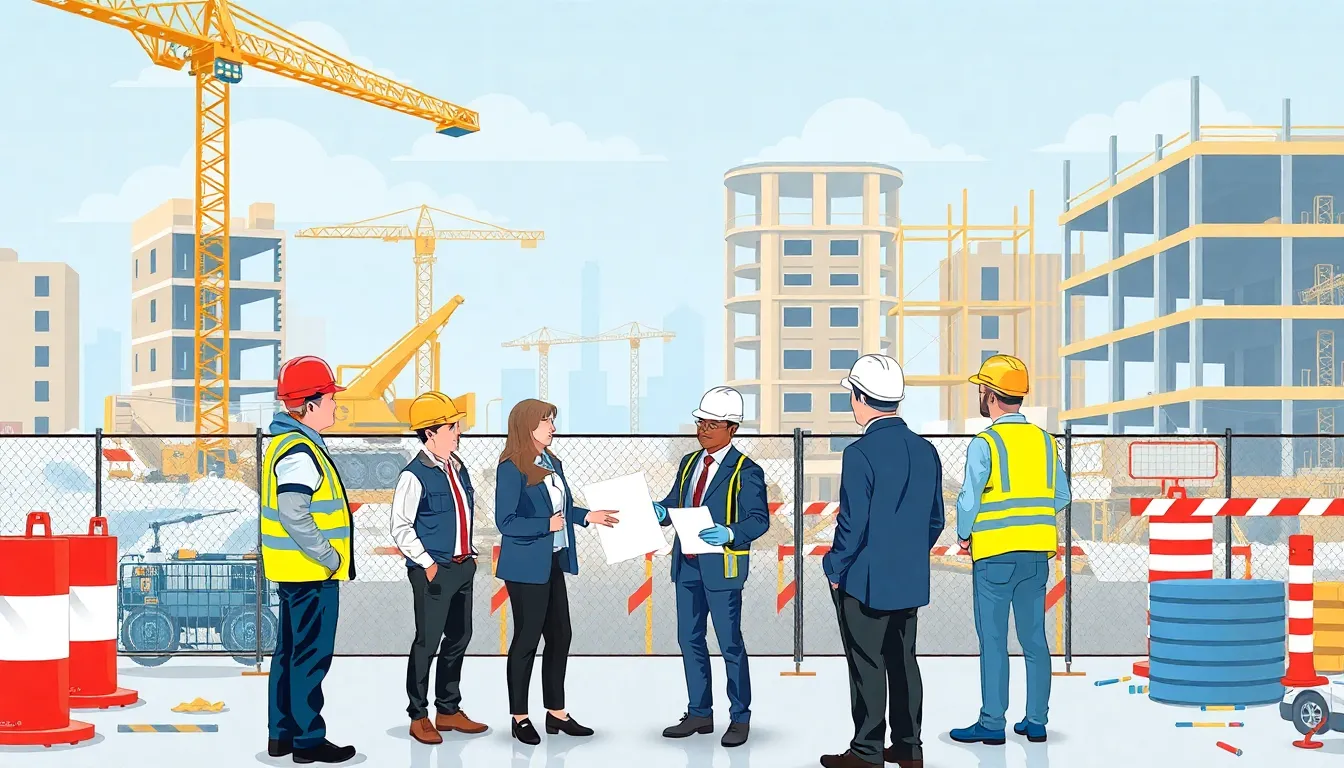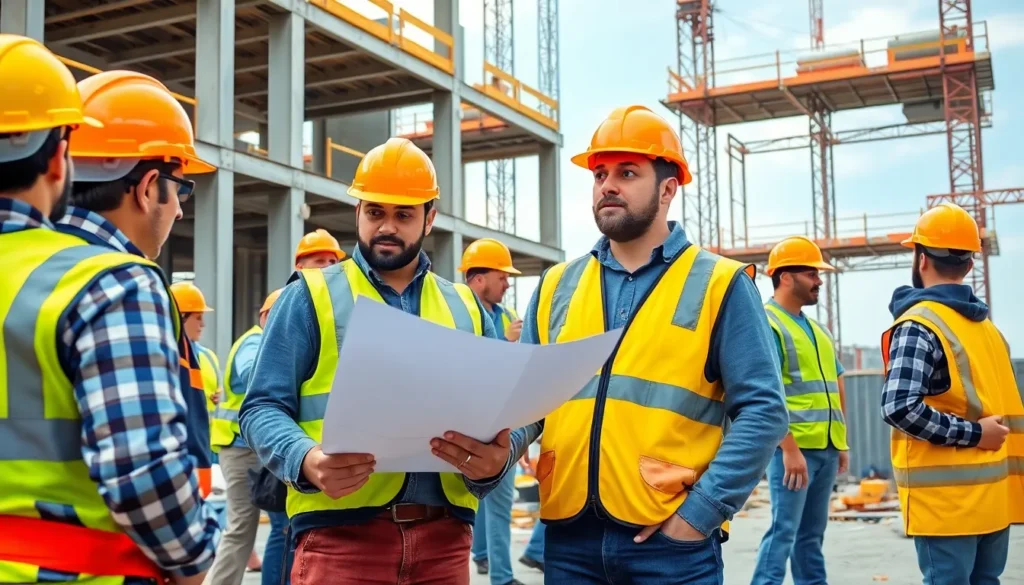Building codes might not be the most thrilling topic, but they’re the unsung heroes of construction. Imagine a world where houses could spontaneously combust or skyscrapers could flop like a bad soufflé. That’s why understanding the different types of construction building codes is crucial for anyone involved in the industry.
Table of Contents
ToggleUnderstanding Type of Construction Building Code
Type of construction building codes categorize structures based on their materials and design, influencing safety protocols and regulatory compliance. Categories include:
- Type I: These buildings utilize non-combustible materials, typically found in high-rise structures. Fire resistance plays a crucial role in this classification.
- Type II: Similar to Type I, these buildings consist of non-combustible materials but with lesser fire-resistance ratings. Generally, they include warehouses and some commercial properties.
- Type III: This category combines combustible and non-combustible materials. Buildings such as those featuring wood framing with non-combustible walls fall under this type.
- Type IV: Heavy timber construction characterizes this type, where large wood members are protected against fire exposure. Educational buildings often adhere to this code.
- Type V: These structures primarily use combustible materials. Residential buildings, including single-family homes and townhouses, often fall into this classification.
Compliance with each type’s specific regulations ensures that structures meet safety standards tailored to their materials. Understanding these classifications is essential for architects, builders, and engineers involved in the design and construction process. Each type’s requirements affect overall project design, impacting material choice and construction methods.
Choosing the appropriate type of construction influences not just safety but also insurance rates and long-term maintenance costs. Stakeholders benefit from comprehensive knowledge of these codes, simplifying the navigation of local building regulations. By prioritizing the correct category, project teams enhance safety measures while streamlining the construction process.
Major Types of Construction Codes

Construction codes ensure buildings meet safety, structural integrity, and accessibility standards. Major classifications include structural codes, fire safety codes, and accessibility codes.
Structural Codes
Structural codes focus on the integrity and stability of buildings. These regulations dictate load capacities, design specifications, and material requirements. Engineers and architects must comply with these standards to prevent structural failures. Structural codes vary based on geographic location and types of occupancy. For example, areas prone to earthquakes require additional reinforcement in design. Proper adherence to structural codes minimizes risks associated with natural disasters and operational stresses.
Fire Safety Codes
Fire safety codes address prevention and response to fire hazards. These codes outline requirements for fire alarms, sprinkler systems, and escape routes. Buildings classified under Type I and Type II must follow stringent fire-resistance ratings. Regular inspections ensure compliance with fire safety standards. Non-compliance can result in penalties and increased insurance costs. Compliance with these codes protects lives and property in case of fire emergencies.
Accessibility Codes
Accessibility codes guarantee equal access to public buildings for individuals with disabilities. Features such as ramps, designated parking, and accessible restrooms fall under these codes. Standards like the Americans with Disabilities Act (ADA) set comprehensive guidelines for design. Architectural plans must incorporate these accessibility features during the construction process. Meeting accessibility codes fosters inclusivity and ensures all community members navigate buildings safely.
Importance of Adhering to Building Codes
Adhering to building codes is critical in the construction industry. These codes ensure safety and structural integrity throughout the lifecycle of a building.
Ensuring Safety and Compliance
Safety and compliance are paramount in construction. Building codes establish minimum safety standards, preventing accidents and structural failures. Each code addresses specific risks related to materials, design, and location. For instance, structural codes dictate the load-bearing capabilities, essential in earthquake-prone areas. Fire safety codes detail requirements for alarm systems and exits to safeguard occupants during emergencies. Accessibility codes ensure spaces are usable by everyone, fostering inclusivity. Compliance protects not only builders but also the public, creating safer environments.
Impact on Insurance and Liability
Insurance premiums often depend on adherence to building codes. Insurers consider compliance a measure of risk when evaluating properties. Structures built according to regulations typically see lower insurance costs, reflecting reduced risk of damage or liability claims. Non-compliance, however, can lead to costly legal issues and extensive fines. Building owners face potential lawsuits if accidents occur in non-compliant structures. Therefore, prioritizing compliance with building codes enhances overall safety and offers financial advantages.
Recent Changes in Construction Building Codes
Recent updates to construction building codes reflect advancements in safety and environmental standards. The introduction of new materials has influenced the evolution of fire safety regulations. For instance, some jurisdictions now mandate the use of fire-resistant materials in Type III and Type V structures. Changes in structural codes emphasize enhanced seismic safety measures in earthquake-prone areas, ensuring buildings withstand significant tremors.
Energy efficiency requirements have seen significant revisions as well, with many codes now enforcing stricter standards for insulation and HVAC systems. These adjustments aim to reduce overall energy consumption and promote sustainable practices in building design. Local code adaptations also incorporate guidelines for renewable energy installations, encouraging the use of solar panels in both residential and commercial spaces.
Accessibility codes continue to advance, aligning with updates to the Americans with Disabilities Act (ADA). Recent modifications include wider doorways and improved signage to enhance navigation for individuals with disabilities. Builders must ensure compliance with these updated standards to foster inclusivity within communities.
Furthermore, the enforcement of compliance measures has tightened over the last few years, with increased inspections and penalties for violations. Regulatory bodies now encourage the adoption of best practices through education and workshops for contractors and builders. As a result, construction professionals must stay informed about these changes to maintain compliance and ensure the safety and integrity of their projects.
Understanding construction building codes is crucial for anyone involved in the industry. These codes not only ensure safety and stability but also influence project design and compliance. By categorizing buildings based on their materials and design, codes help mitigate risks associated with structural failures and fire hazards.
Staying updated with recent changes in building codes is essential for construction professionals. As safety standards evolve, so do the requirements for materials and design. Prioritizing compliance not only enhances safety but can also lead to financial benefits, including lower insurance premiums. Embracing these regulations ultimately fosters a safer environment for communities and promotes responsible building practices.





